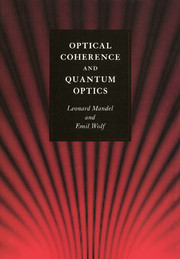Book contents
- Frontmatter
- Contents
- Preface
- 1 Elements of probability theory
- 2 Random (or stochastic) processes
- 3 Some useful mathematical techniques
- 4 Second-order coherence theory of scalar wavefields
- 5 Radiation from sources of any state of coherence
- 6 Second-order coherence theory of vector electromagnetic fields
- 7 Some applications of second-order coherence theory
- 8 Higher-order correlations in optical fields
- 9 Semiclassical theory of photoelectric detection of light
- 10 Quantization of the free electromagnetic field
- 11 Coherent states of the electromagnetic field
- 12 Quantum correlations and photon statistics
- 13 Radiation from thermal equilibrium sources
- 14 Quantum theory of photoelectric detection of light
- 15 Interaction between light and a two-level atom
- 16 Collective atomic interactions
- 17 Some general techniques for treating interacting systems
- 18 The single-mode laser
- 19 The two-mode ring laser
- 20 The linear light amplifier
- 21 Squeezed states of light
- 22 Some quantum effects in nonlinear optics
- References
- Author index
- Subject index
1 - Elements of probability theory
Published online by Cambridge University Press: 05 April 2013
- Frontmatter
- Contents
- Preface
- 1 Elements of probability theory
- 2 Random (or stochastic) processes
- 3 Some useful mathematical techniques
- 4 Second-order coherence theory of scalar wavefields
- 5 Radiation from sources of any state of coherence
- 6 Second-order coherence theory of vector electromagnetic fields
- 7 Some applications of second-order coherence theory
- 8 Higher-order correlations in optical fields
- 9 Semiclassical theory of photoelectric detection of light
- 10 Quantization of the free electromagnetic field
- 11 Coherent states of the electromagnetic field
- 12 Quantum correlations and photon statistics
- 13 Radiation from thermal equilibrium sources
- 14 Quantum theory of photoelectric detection of light
- 15 Interaction between light and a two-level atom
- 16 Collective atomic interactions
- 17 Some general techniques for treating interacting systems
- 18 The single-mode laser
- 19 The two-mode ring laser
- 20 The linear light amplifier
- 21 Squeezed states of light
- 22 Some quantum effects in nonlinear optics
- References
- Author index
- Subject index
Summary
Definitions
The concept of probability is of considerable importance in optics, as in any situation in which the outcome of a given trial or measurement is uncertain. Under these conditions it is desirable to be able to associate a measure with the likelihood of the outcome or the event in question; such a measure is called the probability of the event.
Several different definitions of probability have been adopted at various times in the past. The classical definition is based on an exhaustive enumeration of the possible outcomes of an experiment or trial. If the trial has N distinguishable, mutually exclusive outcomes, which are equally likely to occur, and if n out of these N possible outcomes have an attribute or characteristic that we call ‘success’, then the probability of success in any one trial is given by the ratio n/N. For example, if we roll a die, and if each of the six digits is equally likely to be on top when the die comes to rest, there are N = 6 distinguishable outcomes. If we identify success with an even number, for example, then since there are three different ways in which success can be achieved, it follows that the probability of success when the die is rolled is given by 3/6 = 1/2. Unfortunately, an exhaustive enumeration of all possibilities is not always feasible.
Another common definition of probability is based on the notion of relative frequency of success.
- Type
- Chapter
- Information
- Optical Coherence and Quantum Optics , pp. 1 - 40Publisher: Cambridge University PressPrint publication year: 1995
- 1
- Cited by



